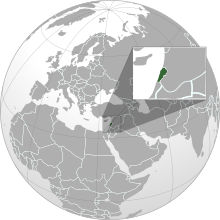اليهود اللبنانيون יהודים לבנונים | |
|---|---|
 | |
| Total population | |
Diaspora: Several thousands[a] | |
| Regions with significant populations | |
| Beirut, Sidon, Tripoli and Aley | |
| Languages | |
| Hebrew, Lebanese Arabic, French | |
| Religion | |
| Judaism | |
| Related ethnic groups | |
| Mizrahi Jews, Sephardi Jews |
| Part of a series on |
| Jews and Judaism |
|---|
The history of the Jews in Lebanon encompasses the presence of Jews in present-day Lebanon stretching back to biblical times. While Jews have been present in Lebanon since ancient times,[2] their numbers had dwindled during the Muslim era.[3] Through the medieval ages, Jewish people often faced persecution,[4] but retained their religious and cultural identity.[5]
In the early 20th century, for a brief period under the French Mandate of Lebanon and 1926 Constitution of Lebanon, the Jewish community was constitutionally protected. However, after 1948, the security of Jews remained fragile, and the main synagogue in Beirut was bombed in the early 1950s.[6] In the wake of the 1967 Arab–Israeli War, there was mass emigration of around 6,000 Lebanese Jews from Lebanon to Israel and Western countries.[7][8][9][10]
The Lebanese Civil War, which started in 1975, brought immense suffering for the remaining Lebanese Jewish community, and some 200 were killed in ensuing anti-Jewish pogroms, leading to a mass exodus of over 1,800 of the remaining Lebanese Jews.[11][12][13] By 2005, the Jewish quarter of Beirut, Wadi Abu Jamil, was virtually abandoned, and there were only around 40 to 200 Jews left in Beirut.[14][15]
- ^ "Abandoned Jewish places across the Arab world | al Bawaba".
- ^ Parfitt, Tudor (2000). Israel and Ishmael: Studies in Muslim-Jewish Relations. p. 87.
- ^ Kirsten Schulze. "Lebanon." Encyclopedia of Jews in the Islamic World. Executive Editor Norman A. Stillman. Brill Online, 2013.
- ^ Parfitt, Tudor (2000). Israel and Ishmael: Studies in Muslim-Jewish Relations. p. 90.
- ^ Parfitt, Tudor (2000). Israel and Ishmael: Studies in Muslim-Jewish Relations. p. 91.
- ^ Collelo, Thomas (December 1987). "Jews". Lebanon: a country study (PDF). Library of Congress Country Studies. pp. 70–71. Retrieved 1 March 2015.
- ^ Lyn Julius (November 4, 2016). "Rewriting Jewish history in Lebanon". Jerusalem Post.
- ^ "Jews of Lebanon captives of hatred bred by civil war". Courier-Post. September 17, 1985.
- ^ "Jews of Lebanon taken hostage by Shiite kidnappers". The Tribune. September 17, 1985.
- ^ "Lebanese Jews Settle Alongside Syrian and Egyptian Jews". The Wisconsin Jewish Chronicle. September 8, 1972.
- ^ "El trato a los judíos en los países árabes o islámicos". biblioteca-tercer-milenio.com (In Spanish). Archived from the original on 8 December 2007.
- ^ "Lebanese Jews in New York: Longing for Home". Al-Akhbar English. April 16, 2012. Archived from the original on September 28, 2013. Retrieved March 18, 2013.
- ^ "Hard to have a minyan". The Wisconsin Jewish Chronicle. September 17, 1982.
- ^ "Lebanon's Jews: Loyalty to Whom? BBC Documentary Tracks Vanished Community". 26 September 2010.
- ^ "Abandoned Jewish places across the Arab world | Al Bawaba". www.albawaba.com. Retrieved 2024-10-02.
Cite error: There are <ref group=lower-alpha> tags or {{efn}} templates on this page, but the references will not show without a {{reflist|group=lower-alpha}} template or {{notelist}} template (see the help page).